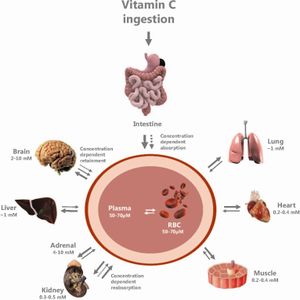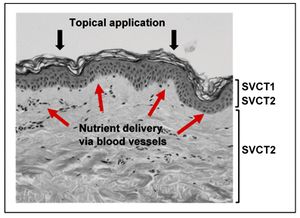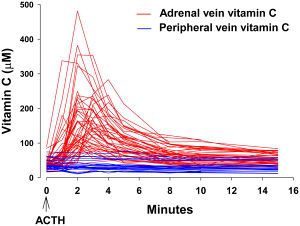- This page was created by volunteers like you!
- Help us make it even better. To learn more about contributing to MEpedia, click here.
- Join the movement
- Visit #MEAction to find support or take action. Donate today to help us improve and expand this project.
- Congratulations!
- MEpedia has got over 30 million views as of August 2022!
Vitamin C
This article needs cleanup to meet MEpedia's guidelines. The reason given is: Text copied and pasted from sourced. Also too much detail and too technical. (May 2020) |
Vitamin C, also known as ascorbic acid, is a water-soluble vitamin found particularly in citrus fruits and green vegetables. It is essential for collagen, catecholamine, and carnitine biosynthesis.[1]
One of its roles is as an antioxidant, that is, it helps to protect cells from damage by oxidative stress and also improves mitochondrial function. Another role is as a cofactor for several enzymes.[2] After absorption, Vitamin C is present throughout the whole body.
Large cross-sectional population studies confirm that vitamin C deficiency is common in humans, affecting 5%–10% of adults in the industrialized world. Moreover, significant associations between poor vitamin C status and increased morbidity and mortality have consistently been observed. However, the absorption, distribution and elimination kinetics of vitamin C in vivo are highly complex, due to dose-dependent non-linearity, and the specific regulatory mechanisms are not fully understood.[3] In addition, the optimal daily intake as well as the typical total body pool of vitamin C during health and disease remain unknown.[4][5][6][7] There are also discrepancies in global vitamin C recommendations, and the various national authorities recommend the minimum amount of vitamin C, however, this is likely not meeting the health needs of various subpopulations. For example, smokers and people with obesity have higher requirements than the general population, and national authorities should reassess their dietary recommendations.[8]

Biology[edit | edit source]
Vitamin C is found in the whole body, even skin tissue.[9][10] High levels of vitamin C are found in the eyes, pituitary, adrenal gland, pancreas, liver, spleen and brain. Vitamin C is also found in relative high levels in the bone marrow, muscles and skin.[10][11] Bone marrow is probably also involved in the vitamin C homeostasis process.[9][12][13]

The adrenal gland can inject vitamin C into the blood.[9]
Too much sun exposure may deplete the Vitamin C stores in the skin tissue.[10]
In human disease[edit | edit source]
Vitamin C is important in mast cell activation disorder for its role in the breakdown of histamine and as a mast cell stabilizer. Vitamin C is also a co-factor in collagen synthesis, making it a potentially important nutrient in Ehlers-Danlos syndrome and other connective tissue disorders.[14][15][16][17][18][19] Deficiency of vitamin C may contribute to osteoporosis.[12][13]
Vitamin C deficiency leads to altered function of procollagen-proline dioxygenase and lysyl hydroxylase enzymes. Each are essential for collagen synthesis and require Vitamin C as a cofactor.[20]
Mast cell activation disorder[edit | edit source]
Numerous studies have found Vitamin C to be inversely correlated with histamine and that the administration of Vitamin C reduces blood histamine levels.[21][22][23] It does this potentially through several mechanisms: by inhibiting mast cell production; by increasing diamine oxidase (an enzyme that breaks down histamine); by inhibiting mast cell degranulation and the release of histamine in the first place (i.e., as a mast cell stabilizer),[24] and by inhibiting histidine decarboxylase (the enzyme that forms histamine).[25]

Ehlers-Danlos Syndrome[edit | edit source]
A case study found improved wound healing in a patient with vascular Ehlers-Danlos Syndrome who was given high-dose (4g/day) oral vitamin C supplementation for two years.[26] A case study of two patients with Kyphoscoliotic EDS received high-dose Vitamin C (5g/day). After one year, they had reduced bleeding time and improve wound healing, and muscle strength.[27]
Supplementation[edit | edit source]
Several studies indicates the recovery from Vitamin C depletion will require several months of treatment. [9]
Notable studies[edit | edit source]
- 2014, Mitochondrial dysfunction and chronic disease: treatment with natural supplements[28] (Full text)
See also[edit | edit source]
- Hypovitaminosis C
- Collagen
- Mast cell activation syndrome
- Vitamin
- Irritable bowel syndrome
- Osteoporosis
- Diet
Learn more[edit | edit source]
References[edit | edit source]
- ↑ Michels, Alexander J.; Hagen, Tory M.; Frei, Balz (2013). "Human Genetic Variation Influences Vitamin C Homeostasis by Altering Vitamin C Transport and Antioxidant Enzyme Function". Annual review of nutrition. 33: 45–70. doi:10.1146/annurev-nutr-071812-161246. ISSN 0199-9885. PMC 4357493. PMID 23642198.
- ↑ National Research Council; Institute of Medicine (2000). Dietary reference intakes for vitamin C, vitamin E, selenium, and carotenoids : a report of the Panel on Dietary Antioxidants and Related Compounds, Subcommittees on Upper Reference Levels of Nutrients and of Interpretation and Use of Dietary Reference Intakes, and the Standing Committee on the Scientific Evaluation of Dietary Reference Intakes, Food and Nutrition Board, Institute of Medicine. Washington, D.C.: National Academy Press. ISBN 0309597196. OCLC 55641398.
- ↑ Lindblad, Maiken; Tveden-Nyborg, Pernille; Lykkesfeldt, Jens (May 2013), "Regulation of Vitamin C Homeostasis during Deficiency", Nutrients (5): 2860–2879, ISSN 2072-6643
- ↑ Ginter, Emil (1979), "Chronic marginal vitamin C deficiency: biochemistry and pathophysiology.", World Rev Nutr Diet (33): 104–141, doi:10.1159/000402551
- ↑ Ginter, Emil (March 1980), "What is truly the maximum body pool size of ascorbic acid in man?", Am J Clin Nutr, 33 (3): 538–539, doi:10.1093/ajcn/33.3.538
- ↑ Ginter, Emil (April 1982), "Optimum Intake of Vitamin C for the Human Organism", Nutrition and Health, 1 (2): 66–77, doi:10.1177/026010608200100202
- ↑ Lykkesfeldt, Jens; Tveden-Nyborg, Pernille (October 2019), "The Pharmacokinetics of Vitamin C", Nutrients, 11 (10), doi:10.3390/nu11102412
- ↑ Carr, AC; Lykkesfeldt, J (2020), "Discrepancies in global vitamin C recommendations: a review of RDA criteria and underlying health perspectives", Crit Rev Food Sci Nutr, 30 (3): 1–14
- ↑ Jump up to: 9.0 9.1 9.2 9.3 Padayatty, Sebastian; Levine, Mark (June 2016), "Vitamin C: the known and the unknown and Goldilocks", Oral Disease, 22 (6): 463–93
- ↑ Jump up to: 10.0 10.1 10.2 Pullar, JM; Carr, AC; Vissers, MCM (2017), "The Roles of Vitamin C in Skin Health", Nutrients, 9 (8): 866
- ↑ Snodgrass, S. Robert (1992). "Vitamin neurotoxicity". Molecular Neurobiology. Springer Science and Business Media LLC. 6 (1): 41–73. doi:10.1007/bf02935566. ISSN 0893-7648. PMID 1463588.
- ↑ Jump up to: 12.0 12.1 Seftel, H; Malkin, C; Schmaman, A; Abrahams, C; Lynch, S; Charlton, S; Bothwell, T, "Osteoporosis, Scurvy, and Siderosis in Johannesburg Bantu", Br Med J, 1 (5488): 642–644
- ↑ Jump up to: 13.0 13.1 Aghajanian, P; Hall, S.; Wongworawat, MD; Mohan, S (2015), "The Roles and Mechanisms of Actions of Vitamin C in Bone: New Developments", J Bone Miner Res, 30 (11): 1945–1955
- ↑ Mantle, D.; Wilkins, R.M.; Preedy, V. (January 1, 2005). "A novel therapeutic strategy for Ehlers–Danlos syndrome based on nutritional supplements". Medical Hypotheses. 64 (2): 279–283. doi:10.1016/j.mehy.2004.07.023. ISSN 0306-9877.
- ↑ Dembure, Philip P.; Janko, Anita R.; Priest, Jean H.; Elsas, Louis J. (July 1, 1987). "Ascorbate regulation of collagen biosynthesis in Ehlers-Danlos syndrome, type VI". Metabolism. 36 (7): 687–691. doi:10.1016/0026-0495(87)90155-7. ISSN 0026-0495.
- ↑ Elsas, Louis J.; Miller, Robert L.; Pinnell, Sheldon R. (March 1, 1978). "Inherited human collagen lysyl hydroxylase deficiency: Ascorbic acid response". The Journal of Pediatrics. 92 (3): 378–384. doi:10.1016/S0022-3476(78)80423-5. ISSN 0022-3476.
- ↑ Kanof, Abram (February 1, 1952). "EHLERS-DANLOS SYNDROME: Report of a Case with Suggestion of a Possible Causal Mechanism". A.M.A. American Journal of Diseases of Children. 83 (2): 197–202. doi:10.1001/archpedi.1952.02040060063007. ISSN 0096-8994.
- ↑ Ringsdorf, W. M.; Cheraskin, E. (March 1, 1982). "Vitamin C and human wound healing". Oral Surgery, Oral Medicine, Oral Pathology. 53 (3): 231–236. doi:10.1016/0030-4220(82)90295-X. ISSN 0030-4220.
- ↑ Royce, Peter M.; Steinmann, Beat (April 14, 2003). Connective Tissue and Its Heritable Disorders: Molecular, Genetic, and Medical Aspects. John Wiley & Sons. ISBN 978-0-471-46117-3.
- ↑ Wu, Marlyn; Crane, Jonathan S. (2019). Biochemistry, Collagen Synthesis. Treasure Island (FL): StatPearls Publishing. PMID 29939531.
- ↑ Clemetson, C.A. (April 1980), "Histamine and ascorbic acid in human blood", The Journal of Nutrition, 110 (4): 662–668, ISSN 0022-3166, PMID 7365537
- ↑ Johnston, C.S.; Martin, L.J.; Cai, X. (April 1992), "Antihistamine effect of supplemental ascorbic acid and neutrophil chemotaxis", Journal of the American College of Nutrition, 11 (2): 172–176, ISSN 0731-5724, PMID 1578094
- ↑ Johnston, CS; Solomon, RE; Corte, C (December 1996). "Vitamin C depletion is associated with alterations in blood histamine and plasma free carnitine in adults". J Am Coll Nutr. 15 (6): 586–591. doi:10.1080/07315724.1996.10718634.
- ↑ Mio, M (1999). "Ultraviolet B (UVB) light-induced histamine release from rat peritoneal mast cells and its augmentation by certain phenothiazine compounds". Immunopharmacology.
- ↑ Molderings, Gerhard (2016). "Pharmacological treatment options for mast cell activation disease". Naunyn Schmiedebergs Arch Pharmacol.
- ↑ Ringsdorf, W. M.; Cheraskin, E. (March 1, 1982). "Vitamin C and human wound healing". Oral Surgery, Oral Medicine, Oral Pathology. 53 (3): 231–236. doi:10.1016/0030-4220(82)90295-X. ISSN 0030-4220.
- ↑ Dembure, Philip P.; Janko, Anita R.; Priest, Jean H.; Elsas, Louis J. (July 1, 1987). "Ascorbate regulation of collagen biosynthesis in Ehlers-Danlos syndrome, type VI". Metabolism. 36 (7): 687–691. doi:10.1016/0026-0495(87)90155-7. ISSN 0026-0495.
- ↑ Nicolson, Garth L. (2014). "Mitochondrial dysfunction and chronic disease: treatment with natural supplements". Alternative Therapies in Health and Medicine. 20 (Suppl 1): 18–25. ISSN 1078-6791. PMID 24473982.

